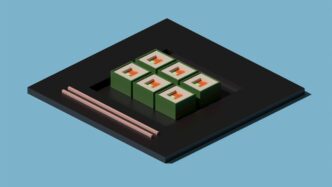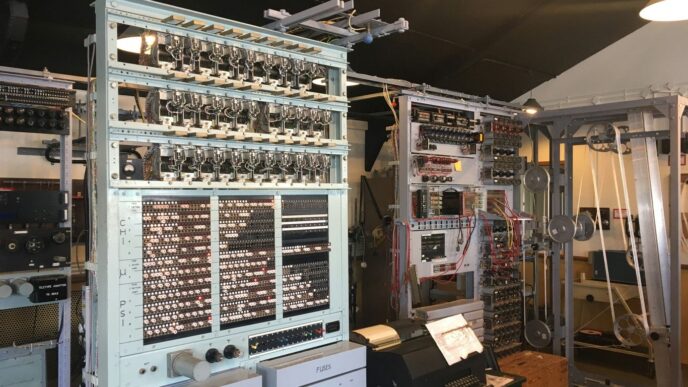So, quantum computing. It sounds like something out of a sci-fi movie, right? But it’s actually becoming a real thing, especially when we talk about the chips that power these machines. In 2025, the companies making these quantum chips are really shaking things up. We’re seeing new ideas pop up everywhere, from using light to do calculations to building super stable qubits. It’s a pretty exciting time, and a lot is happening with these quantum chip manufacturers.
Key Takeaways
- Microsoft is making big moves with its topological qubits, aiming for more stable quantum computers.
- Xanadu is pushing forward with photonic quantum computing, using light to process information, and partnering with companies like Disco for better manufacturing.
- China is focusing on making its own advanced chip-making tools, like the ‘Xi Zhi’ system, to become more independent in producing quantum chips.
- Creating quantum chips that are stable and can be made in large numbers is still a big challenge, but new hybrid designs and manufacturing ideas are trying to solve this.
- The competition among quantum chip manufacturers is heating up, with both big companies and small startups trying to lead the way in this new technology.
Key Quantum Chip Manufacturers Driving Innovation
Alright, so 2025 is shaping up to be a pretty wild year for quantum chips. It feels like every week there’s some new development that makes you stop and think, ‘Wow, this is actually happening.’ We’re seeing a few big players really pushing the envelope, and it’s not just one type of technology leading the charge. It’s a mix of different approaches, each with its own strengths, that are making quantum computing feel a lot closer to reality.
Microsoft’s Topological Breakthroughs
Microsoft has been talking about topological qubits for a while now, and in early 2025, they really showed their hand with the Majorana 1 chip. The big idea here is using something called ‘topoconductors’ to create qubits that are naturally more stable. Think of it like building a house with really strong foundations – these topological qubits are supposed to be way less prone to errors caused by noise or interference. This focus on stability is a huge deal because it’s one of the main roadblocks to building large-scale quantum computers. They’re aiming for a million qubits on a single chip, which is just mind-boggling, and the hope is that these qubits will be faster and more reliable than the ones we’ve seen before. It’s a bold move, and if it pans out, it could seriously speed up the timeline for practical quantum applications.
Xanadu’s Photonic Advancements
Then you’ve got Xanadu, a Canadian company that’s all about using light – photons – to do quantum computing. Photonic quantum computing has this cool advantage: it can often work at room temperature, which simplifies things a lot compared to systems that need super-cold environments. Xanadu has been busy, too. They’ve got this prototype called Aurora, which uses a bunch of chips and a frankly absurd amount of fiber optic cable to perform calculations. What’s really interesting is their partnership with Disco, a company that makes specialized manufacturing equipment. They’re working together to make photonic chips even better, specifically by improving how they’re cut and polished to reduce signal loss. Xanadu also opened a new facility in Toronto this year, which is a clear sign they’re serious about scaling up their production.
China’s Self-Reliance in Chip Production
China is also making some serious noise in the quantum chip space, particularly with their focus on developing their own advanced manufacturing tools. They’ve introduced a new electron beam lithography system called ‘Xi Zhi.’ This machine is pretty impressive; it can etch circuits with incredible precision, down to 0.6 nanometers. What’s significant about ‘Xi Zhi’ is that it’s not only precise but also more affordable than similar systems from other countries. This is part of a larger push for China to become more self-sufficient in high-end chip manufacturing, reducing reliance on foreign technology. They’re not just talking about it; they’re building the tools to make it happen, which could have a big impact on the global supply chain for advanced semiconductors, including those needed for quantum computing.
Emerging Technologies in Quantum Chip Design
Quantum chip design is really heating up, with a few key areas showing a lot of promise for making these powerful machines more practical. It’s not just one path forward; different approaches are being explored, each with its own strengths.
The Rise of Photonic Quantum Computing
One exciting direction is using light, or photons, to do the quantum computing. This is called photonic quantum computing. The big draw here is that these systems can often work at room temperature, which is a lot simpler than needing super-cold environments. Plus, they seem to have a good shot at scaling up. Companies like Xanadu are really pushing this. They’ve even partnered with manufacturing experts like Disco to make sure their photonic chips are top-notch, minimizing signal loss during production. Their Aurora prototype, a 12-qubit machine, shows just how far this technology has come, using a lot of fiber optics and specialized chips.
Electronic-Photonic Hybrid Chip Integration
What’s really new and interesting in 2025 is the development of chips that mix electronics and photonics. Imagine having the quantum light sources and the control electronics all on the same piece of silicon. Researchers have managed to do just that, creating a chip that’s only about a millimeter square. This integration is a big deal because it helps stabilize the delicate quantum signals, which is a major hurdle. This kind of hybrid design uses standard manufacturing methods, making it much easier to produce these chips in larger quantities. It’s a smart way to bring quantum tech closer to real-world use.
Topological Qubits for Stability and Scale
Then there’s the work being done on topological qubits. Microsoft, for instance, has been talking about their Majorana 1 chip. The idea here is to use special materials and principles from topology to create qubits that are naturally more stable and less prone to errors. Think of it like building a qubit that’s inherently protected from noise. The goal is to eventually get to millions of these qubits on a single chip, which would be a massive leap forward. These qubits are expected to be faster and more reliable than some of the older designs, potentially speeding up the timeline for practical quantum computers.
Challenges and Solutions in Quantum Chip Manufacturing
Building quantum chips isn’t exactly like making your average computer chip, and there are some pretty big hurdles to jump over. For starters, keeping qubits stable is a massive headache. These tiny quantum bits are super sensitive to their surroundings – think vibrations, temperature changes, even stray magnetic fields. One wrong move and poof, your quantum state is gone. This sensitivity is the main reason why we don’t have millions of qubits working together perfectly just yet.
Then there’s the whole scalability thing. We’re talking about needing potentially millions of qubits for truly powerful quantum computers, and right now, getting even a few hundred to work reliably is a serious engineering feat. It’s like trying to build a skyscraper with LEGOs – you need a lot of them, and they all have to fit just right.
And let’s not forget about the cost. Developing and manufacturing these advanced chips is incredibly expensive. This makes quantum computing a luxury item, accessible only to big research institutions and corporations. We need ways to bring those costs down if we want this technology to really take off and be used by more people.
Addressing Stability and Scalability Hurdles
So, how are folks trying to fix this? For stability, researchers are exploring different qubit types. Microsoft, for instance, is betting big on topological qubits. These are theoretically much more robust against environmental noise because the quantum information is encoded in a way that’s protected by the physics of the material itself. It’s a bit like having a built-in shield.
On the scalability front, there’s a lot of work going into hybrid approaches. Think combining the best of different worlds. For example, the development of electronic-photonic hybrid chips is a big deal. These chips put quantum light sources and the electronic controls needed to manage them all on the same piece of silicon. This integration, using standard manufacturing processes, is a promising path toward making more qubits without needing entirely new factories. It’s a step towards making quantum computers more practical.
Reducing Costs for Broader Accessibility
Bringing down the price tag is key. One way this is happening is through innovations in manufacturing tools. China’s "Xi Zhi" electron beam lithography system is a good example. It offers high precision for chip design and is being offered at a lower cost than comparable international systems. This kind of development can democratize access to advanced chip-making capabilities.
Another strategy is to adapt existing manufacturing infrastructure. Instead of building entirely new, super-expensive quantum chip factories from scratch, companies are looking at how to use or modify current semiconductor fabrication lines. This reuse of established processes, especially for components like photonic chips, can significantly cut down on the capital investment needed. It’s about working smarter, not just harder, to make quantum tech more affordable.
Integrating Quantum Components with Classical Systems
This is where things get really interesting, and frankly, a bit tricky. Quantum computers won’t replace your laptop anytime soon; they’ll likely work alongside classical computers. The challenge is making these two very different types of systems talk to each other effectively. We need interfaces that can translate quantum operations into classical commands and vice-versa, without losing precious quantum information in the process.
One approach is the electronic-photonic hybrid chip we mentioned. By integrating quantum elements directly with classical control electronics on the same chip, you simplify the connection. It’s like building a translator directly into the device rather than needing a separate interpreter. This integration is vital for creating functional quantum systems that can be controlled and utilized by existing classical infrastructure, paving the way for more complex applications.
Global Players in the Quantum Chip Arena

It feels like every week there’s a new company or country making waves in the quantum chip world. It’s not just a few big tech giants anymore; a whole ecosystem is popping up. We’ve got established corporations pouring in serious cash, alongside nimble startups trying to carve out their niche. Plus, there’s a lot of international teamwork happening, which is pretty cool to see.
Major Corporations Investing in Quantum
Big names like IBM, Google, and Intel have been in this game for a while, pushing the boundaries with their own approaches to quantum hardware. Microsoft, with its focus on topological qubits, is another major player to watch. They’re not just dabbling; they’re making significant bets on specific technologies they believe will lead the pack. Amazon also has a stake, showing that cloud providers see quantum computing as the next frontier.
Specialized Quantum Chip Startups
Beyond the giants, there’s a vibrant scene of startups. Companies like Rigetti Computing and IonQ are developing their own quantum processors, often focusing on specific qubit technologies like superconducting circuits or trapped ions. Then you have Xanadu, really pushing the envelope with photonic quantum computing, even partnering with manufacturing firms to get their chips made. These smaller outfits are often more agile, able to pivot quickly and explore more experimental ideas.
International Collaborations and Partnerships
Nobody’s really going it alone these days. We’re seeing a lot of cross-border efforts. For instance, Xanadu is working with Japan’s Disco on manufacturing techniques for photonic chips. These kinds of partnerships are super important because building quantum computers requires a mix of cutting-edge physics, advanced engineering, and specialized manufacturing – skills that no single company or country necessarily has all of. It’s a global race, but collaboration seems to be a key strategy for making real progress.
The Future Trajectory of Quantum Chip Development
So, what’s next for quantum chips? It feels like we’re really on the cusp of something big, you know? The progress we’ve seen lately, especially in 2025, is pretty wild. We’re talking about chips that could solve problems that are just impossible for today’s computers.
Advancements in Qubit Stability and Coherence
One of the biggest headaches in quantum computing has always been keeping those delicate qubits stable. They’re super sensitive to their surroundings – a tiny bit of heat or vibration can mess everything up. But companies are making real headway here. Microsoft’s work with topological qubits, for instance, is a game-changer. They’re using these special materials that are inherently more robust. Think of it like building a house with super-strong bricks that don’t crumble easily, rather than using flimsy ones. This means fewer errors and a much better chance of actually getting useful results from these machines. It’s not just about having more qubits; it’s about having qubits that actually work reliably for longer periods.
The Path Towards Mass Production
Getting from a few fancy qubits in a lab to millions of them on a chip that can be made reliably is a whole other ballgame. This is where things like China’s "Xi Zhi" electron beam lithography system come into play. It’s all about precision manufacturing. Being able to etch circuits with that level of detail, and doing it more affordably, is key. We’re also seeing hybrid approaches, like those electronic-photonic chips. They’re trying to combine the best of both worlds – the quantum power of photonics with the established manufacturing techniques of electronics. It’s like trying to put a super-advanced engine into a car that’s already built using standard parts, making it easier to build more of them.
Applications Driving Quantum Chip Demand
Why are we even bothering with all this? Well, the potential applications are enormous. We’re not just talking about faster internet here. Imagine designing new medicines by simulating molecules with incredible accuracy, or creating entirely new materials with properties we can only dream of today. AI could get a massive boost, and some of the toughest encryption methods we use could become obsolete, requiring new quantum-resistant ones.
Here’s a quick look at some areas where quantum chips are expected to make a big splash:
- Drug Discovery and Materials Science: Simulating complex molecular interactions to design new drugs and advanced materials.
- Financial Modeling: Optimizing portfolios and risk analysis with unprecedented speed.
- Artificial Intelligence: Training more complex AI models and improving machine learning algorithms.
- Logistics and Optimization: Solving incredibly complex supply chain and routing problems.
It’s this promise of solving previously unsolvable problems that’s really pushing the development forward. The demand is growing because the potential payoff is just too big to ignore.
China’s Strategic Push in Quantum Chip Manufacturing
China’s been making some serious moves in the quantum chip world lately. It’s not just about keeping up; it’s about building their own path. A big part of this is their focus on self-reliance, especially when it comes to the high-tech tools needed to actually make these chips. Think of it like building a whole new factory from scratch, but for something as complex as quantum computers.
The ‘Xi Zhi’ Electron Beam Lithography System
One of the standout developments is the "Xi Zhi" electron beam lithography system. Developed by Zhejiang University, this machine is pretty impressive. It uses an electron beam to etch circuits with incredible precision – we’re talking 0.6 nanometer precision. This is a huge deal because it means they can design and build chips with much finer detail, without needing those traditional masks that can be a bottleneck. This system is a key step in China’s effort to reduce reliance on foreign technology for advanced semiconductor tools. It’s also being priced competitively, making it an attractive option for domestic companies. This kind of domestic capability is what allows them to push forward on their own terms.
Commercialization of Advanced Semiconductor Tools
It’s not just about having the technology; it’s about making it available. China is actively working to commercialize these advanced tools. This means getting them out of the lab and into the hands of manufacturers. The goal is to create a robust domestic supply chain for quantum chip production. This approach helps lower costs and speeds up the development cycle. It’s a smart strategy for building a strong presence in the global quantum arena. The U.S. Commission on China has even recommended a "quantum-first" national goal, highlighting the global importance of these advancements [e978].
Impact on Global Quantum Chip Landscape
What does all this mean for the rest of the world? Well, China’s progress is definitely shaking things up. By developing its own advanced manufacturing capabilities, it’s creating a more competitive global market. This push for independence means we’re likely to see more diverse approaches and potentially faster innovation across the board. It’s a complex picture, but one thing is clear: China is playing a significant role in shaping the future of quantum chip manufacturing. Their advancements in areas like electron beam lithography are not just national achievements; they have ripple effects that influence the entire industry.
Looking Ahead
So, where does all this leave us in 2025? It’s pretty clear that quantum chip development isn’t just a science project anymore. We’re seeing real progress, with companies like Microsoft and Xanadu pushing the envelope, and even countries like China investing heavily in their own tech. The idea of integrating these powerful quantum systems into everyday manufacturing is starting to feel less like science fiction and more like a genuine possibility. While there are still big challenges, like making these chips stable and affordable, the pace of innovation is undeniable. It feels like we’re on the cusp of something big, and keeping an eye on these manufacturers will be key to understanding where computing is headed next.
Frequently Asked Questions
What exactly are quantum chips and why are they a big deal?
Think of quantum chips as the super-brains for quantum computers. Unlike the chips in your phone or computer that use bits (either a 0 or a 1), quantum chips use ‘qubits.’ Qubits are special because they can be a 0, a 1, or both at the same time! This ‘both’ trick, called superposition, lets quantum computers solve really hard problems much, much faster than regular computers. They could help us discover new medicines, create amazing new materials, or even break secret codes.
Who are the main companies making these cool quantum chips?
Lots of big companies and smart startups are racing to build the best quantum chips. Microsoft is working on special ‘topological qubits’ that are supposed to be more stable. Xanadu in Canada is using light (photons) to build their chips, which might be easier to make lots of. Companies in China are also developing their own advanced tools to make chips. Big names like Google, IBM, and Intel are also investing a lot in this technology.
Are there any tricky problems that make building quantum chips hard?
Yes, definitely! Quantum chips are super sensitive. Even tiny vibrations or changes in temperature can mess them up, making them unstable. It’s also really hard to make them bigger and connect more qubits together – that’s the ‘scalability’ problem. Plus, making these chips is very expensive right now, which makes it hard for everyone to get access to them.
What’s new and exciting in how quantum chips are being made?
One really neat development is combining light-based parts (photonics) with regular electronic parts on the same chip. This ‘hybrid’ approach could make chips more stable and easier to manufacture using existing factory methods. Also, companies are exploring different types of qubits, like Microsoft’s topological qubits, which are designed to be extra tough against errors.
How is China getting involved in making quantum chips?
China is putting a lot of effort into making its own advanced chip-making technology. They’ve developed a special machine called ‘Xi Zhi’ that uses electron beams to draw incredibly tiny circuits with amazing accuracy. This helps them build chips without relying on technology from other countries, which is important for their own research and development in quantum computing.
What does the future look like for quantum chips?
The goal is to make quantum chips that are super stable, can handle way more qubits, and are cheaper to produce. Scientists are working hard on these challenges. As the chips get better, we’ll see more real-world uses, like in medicine, finance, and creating new materials. We’re moving from just having lab experiments to thinking about making these chips in larger quantities for actual use.














